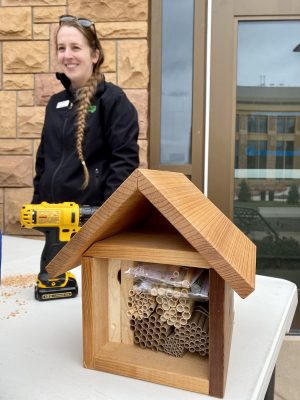Native bees in Wyoming range from 0.1 inches in length—smaller than a grain of rice—to just over 1 inch in length, but all are extremely important pollinators of the state’s native plants. The University of Wyoming Berry Biodiversity Conservation Center will be all abuzz celebrating these important insects during the third annual Bee Jubilee Saturday, June 29, from 10 a.m.-noon. The event is free and open to the public.

“There will be displays of vertebrate and invertebrate pollinator specimens, as well as opportunities to learn about native gardens; observe and identify, up close, pollinators in the ‘Berry Prairie’ garden; build a bee house to take home; and purchase native bee and plant guides,” says Mason Lee, senior project coordinator for the UW Biodiversity Institute, which will host the event.
Additionally, there will be a pollinator yoga class led by a UW group fitness yoga instructor from 10-10:30 a.m. on the tree deck outside the Berry Center. Yoga mats will be provided. A Habitat Hero workshop, led by Carol Bilbrough, a Wyoming Naturalist Program volunteer, is scheduled from 11-11:40 a.m. in the Berry Center auditorium.
“Worldwide, over 75 percent of our major crop species benefit from invertebrate and vertebrate pollination,” Lee says. “Even crops that don’t need an animal pollinator produce a higher yield if they’re visited by native bees.”
Bee Jubilee event partners are UW Extension, UW’s Half Acre Recreation and Wellness Center, the UW Museum of Vertebrates, the Laramie Audubon Society, and the Wyoming Naturalist Program.
For more information about the Bee Jubilee, call Lee at (307) 766-6240 or email mlee37@uwyo.edu.
About the University of Wyoming Biodiversity Institute
The UW Biodiversity Institute fosters conservation of biodiversity through scientific discovery, creative dissemination, education and public engagement. In this setting, scientists, citizens, students, and educators come together to share a wealth of perspectives on the study and appreciation of biodiversity—from microbes to poetry and ecosystems to economics. Learn more at www.wyomingbiodiversity.org.
This story was originally published on UW News.




